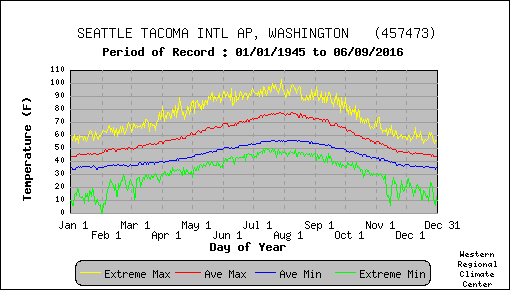Is the Northwest Experiencing and Threatened by False Spring?
During the past week, several Seattle Times articles have been headlining that western Washington is experiencing a "false spring."
Seattle Near Noon Today
Furthermore, some environmental groups are warning that false spring is threatening wildlife and that false springs are the result of climate change (global warming).
So for those of you worried about the "false spring" threat, let me note that Seattle is NOT known for false springs, that we have some of the longest springs in the nation, and there is NO evidence that a warming planet is producing more "false spring" warm-ups in our region.
Spring 101
Everyone knows that astronomical spring runs from roughly March 21-June 21st. But meteorological spring can be very different, depending on your definition.
Here in Washington State, I have suggested that meteorological spring typically starts around the third week of February (yes...next week!).
My reasoning? The probability of strong Pacific cyclones, atmospheric river flooding, and lowland snow drops rapidly after that. The sun is getting rapidly stronger now...and days are longer... so when there are breaks in the clouds and storms, temperatures surge upwards into the 50s and even 60s.
This is normal and typical for our region.
Take a look at the average highs (red lines) and record daily highs (yellow lines) at Seattle-Tacoma Airport (below). Seattle has a slow steady warming from January 1 through mid-July--so our spring lasts a long time. And you will notice that the record high virtually every day in February is in the mid to upper 60s. Nothing unusual.
Sunday's high temperature in Seattle? 57F. Above normal but unremarkable.
Meteorologists at the Iowa Environmental Mesonet (IEM) have come up with their own approach to define the start of spring: they find the coldest 91-day period of the year (which they call winter), with the next day being the start of spring (see map below). Their analysis suggests the start of spring in western Washington is on February 23-25, dates consistent with my analysis based on storms and snow. Spring ends later over the eastern U.S.
So why does spring start early over western Washington?
I believe the answer relies on the mild Pacific Ocean (which is around 50F all year) and the blocking of cold air by the Rockies and Cascades.
It is difficult for western Washington to really chill down. Onshore flow brings in mild Pacific air and the Rockies/Cascades stop the cold air from the continental interior from reaching us--keep real winter at bay. Soil temperatures never get that cold and we rarely have snow coverage of any real depth.
So if we are relatively mild all year, as soon as we get into February, with is stronger sun, temperatures can warm to "springtime" levels if we get a break in the clouds. Nothing unusual at all. No false spring.
Are Spring Record High Temperatures Increasing?
There are some stories suggesting that "false springs" are getting more frequent or warmer. Is this true? Are we seeing more record high temperatures in spring?
Professor John Christy of the University of Alabama, and Alabama State Climatologist, ran the numbers (see below). There is no trend toward more daily high-temperature records over Oregon and Washington from January to March. So no hint of an increasing "false spring" menace.
The Bottom Line
There is no false spring phenomenon going on around here. False springs are not increasing due to global warming.
Perhaps it is a slow news day at the Seattle Times and a few other media outlets that repeated their story.










Comments
Post a Comment